Works Cited for “The Birds”
Žižek, Slavoj and Miller, Richard. “Hitchcock.” The MIT Press 38 (1986): 99-111. Print.
Margaret Horwitz, “The Birds: A Mother’s Love,” in Marshall Deutelbaum and Leland Poague, eds., A Hitchcock Reader (Ames: Iowa State University Press, 1986), 279-87.
Sterritt, David. The Films of Alfred Hitchcock. Cambridge: Cambridge University Press, 1993. Print.
Dick, F. Bernard. “Hitchcock’s Terrible Mothers”. EBSCO Publishing (2003): 238-249. Print.
Bishop, Williams Kyle. “The Threat of the Gothic Patriarchy in Alfred Hitchcock’s “The Birds”. Rocky Mountain Review 65.2 (2011): 135-147.
Lewis, J. Michael. “The Canonical Alfred Hitchcock”. Populate Culture and The Academy (2010): 458-468.
Hitchcock Horror
The Birds is a unique combination of Hitchcock’s style and horror movie tropes. The changes in adapting Du Maurier’s short story result in the opening for a freighting and gripping film. Altering the main character to a woman, making her a glamorous blonde in keeping with Hitchcock’s style and concentrating immensely on the other female characters added an interesting subplot with the conflicts between them and a psychological element with Lydia and how she related to the other characters. The addition of the townspeople brought with it familiar horror traits that may have been new for the time but are stable concepts now. Keeping the ending as mysterious as Du Mauriers, the film retains a sense of dread and terror. The birds are as menacing and as powerful. All the elements from the decisions in varying from the story, to the refocusing of the characters, the inclusion of new characters and an objectively accurate ending makes The Birds a specifcally Hitchcockian horror film.
The Ending of “The Birds”.
In the process of making the film Hitchcock changed the ending from Du Maurier’s original while still keeping the essence of its meaning. Du Maurier’s ending focused on what would happen to the family, they are trapped in the house unable to escape simply waiting for the birds to kill them. The father Nat is described as standing over the fire place, everyone remaining quiet as the sound of the birds trying to break in is in the background, he flicks his last cigarette and it ends. Du Maurier doesn’t confirm the faith of the family, she leaves the ending ambiguous letting the reader decide what happens (even though it’s clear that there’s no way out).
Hitchcock’s ending keeps some focus on the family but the motivation for them leaving is to save the injured Melanie. They slowly carry her into the car and carefully attempt to start it without arousing the wrath of the birds that appear everywhere.
Through this long shot Hitchcock shows the risk that they are taking in trying to find help, the birds have seemingly taken over the surroundings. Unlike the family in Du Maurier’s story who accept their faith, the Brenner’s in Hitchcock’s take action. In the distance there is an almost heavenly light coming from the sky parting the clouds that can be seen as a good omen like a guiding beacon. This family would seem to have a chance at survival, at least a better chance than the Hocken’s ever had.
The ending used in the film wasn’t supposed to be used instead during the last days of shooting Hitchcock decided to scrap Evan Hunters screenplay ending. The original idea was to show the birds attacking the family, to put on display the carnage caused by them to the town and eventually the world outside of Bodega bay. The birds had in a way declared war as Evan put in on humans and it was a fight for survival. This ending would have made the film appear more horror than suspenseful; people trying to escape, a final attack by the threatening force and a decisive conclusion. In his journal Kyle William Bishop notes the horror aspects and the similarities between the film and the story, “…by retaining du Maurier’s flocks of murderous birds, Hitchcock also created his only supernatural horror film, a movie that crosses the boundary into science fiction and leaves viewers with an uncanny and unresolved conclusion (very much in the tone, if not in the details, of du Maurier’s story). Thus, both du Maurier’s original tale and Hitchcock’s film version depict possible versions of the apocalypse, a world where nature has turned against humanity to cause inexplicable turmoil and carnage.”
Although this ending wasn’t the original idea, Hitchcock chose an ending that was faithful to Du Maurier’s story. This act of fidelity doesn’t give the viewer a definite resolution, but brings about more questions like; what happens to the family? Will they survive? How did these attacks start? What caused the birds attack the humans? How far has it spread? Etc. None of these questions are answered, but they open the door for debate, discussion and analysis.
The Women in “The Birds”.
Over the course of his career, Hitchcock has used a very specific type of leading lady: they were blonde, incredibly beautiful and almost always needed rescuing. These women consisted of some of Hollywood’s most glamorous starlets; Grace Kelly, Ingrid Bergman and Kim Novak were frequently cast in his films.
The film made a significant change in the way women were portrayed, in Du Maurier story the female characters are mostly in the background. There’s Nat Hocken’s wife (she doesn’t even have a name), his daughter, and a brief mention of a local farmer’s wife. Most of the story focuses on Nat himself trying to protect his family and the female characters are there just to react to the frightening bird attacks. Hitchcock instead made his film mostly about the female characters, making them more of a presence in the story to the point of overshadowing the male lead.
The main character Melanie Daniels (Tippi Hedren) was meant to represent the modern woman of the time; she was straightforward, sexually fierce and was not afraid to pursue her interests wherever they took her. Her interest in this case was the handsome block of wood that is Mitch Brenner (Rod Taylor) and it has brought her to Bodega bay where she would encounter the other female characters.
Lydia Brenner (Jessica Tandy) is a possessive woman who is most interested in keeping her son to herself. This was not unusual for a Hitchcock film if they ever featured a maternal character she was usually manipulative and controlling; Mrs. Bates in Psycho (1960) who had great effect on Norman and Madame Sebastian in Notorious (1946) who influences her son’s actions personally and professionally are notable examples.
Annie Hayworth (Suzanne Pleshette) acts as almost a counterpoint to Melanie; she is a brunette, she has a working job and is more reserved in her approach. While Melanie simply got in her car and went after Mitch, Annie hasn’t gotten over him and stays in the town unable to tell Mitch her feelings.
The main factor that these women have in common is Mitch, although he isn’t the main character and his presence goes relatively unnoticed, he isn’t anywhere as fleshed out as the female characters. The women are given time to develop through dialogue and narrative events that gives detail to their personalities. The audience even gets to see them all separately on-screen, very different to Du Marier’s story where all the events are filtered through Nat Hocken’s.
Because of the female characters connections to Mitch tension is built between them, especially between Melanie and Lydia. As Margaret Horwitz point out in her journal, “I believe that in The Birds, as in Psycho, the heroine is punished by the hero’s mother because of the heroine’s desirability to him.” This is definitely found in the film as Lydia is quite critical of Melanie and passively objects to her pursing her son. Horwitz even gives an explanation as to why this is, “This process is a result of the male character’s inability to successfully resolve a Oedipal relationship.” The Oedipus complex coming from the Freudian theory seems to offer a reason for Lydia resentment of Melanie. Mitch still visits his mother and that attachment is threatened by the arrival of a new woman, in the form of Melanie.
Slavoj Žižek and Richard Miller have a similar idea, calling it the “Maternal Superego” and using it to link other Hitchcock film, North by Northwest(1959) and Psycho(1960), together through this motif, “…the heroes of these three films are fatherless, they have a mother who is “strong,” who is “possessive,” who perturbs the “normal” sexual relationship. At the very beginning of North by Northwest the film’s hero, Roger Thornhill (Cary Grant), is shown with his scornful, mocking mother, and it is not difficult to guess why he has been four times divorced; in Psycho, Norman Bates (Anthony Perkins) is directly controlled by the voice of his dead mother, which instructs him to kill any woman to whom he is sexually attracted; in the case of the mother of Mitch Brenner (Rod Taylor), hero of The Birds, mocking disdain is replaced by a zealous concern for her son’s fate, a concern that is perhaps even more effective in blocking any lasting relationship he might have with a woman.” Žižek and Miller observe that this is a trend in Hitchcock films; the mother deceivingly trying to sabotage the son’s relationship with any other women so as to keep him to herself.
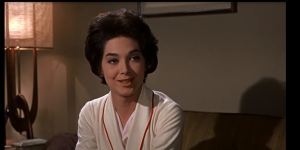 Annie explaining what happened between her and Mitch.
Annie explaining what happened between her and Mitch.
In The Birds, Lydia has already sabotaged one of Mitch’s past relationships, the one with Annie as Bernard F. Dick point out, “Had the birds not intervened, Lydia would have done to Melanie what she did to Annie (Suzanne Pleshette): break up her relationship with Mitch and then take on Melanie as a friend, now that she is no longer a threat to the Brenner household.” Lydia is overprotective of her household and although she perceives the other women as threats she doesn’t outright hate them, she even befriends Annie after she breaks up with Mitch. Lydia needs to keep her home strictly family only unwilling to share what she sees as hers with anyone else. Bernard goes on to find a common point that the three women share, “Actually all the women in the film are like two-way mirrors, each reflecting her own image and the others. They have all lost someone: Annie lost Mitch, Melanie lost her mother, Cathy lost her father, and Lydia lost her husband.” The women are bonded by loss that drives their motivations.
Melanie’s loss of her mother could be why she so enthusiastically pursues Mitch, trying to fill a void through flirtatious encounters, as described in the film she is a wondering socialite without any real meaning to her actions. Lydia’s loss of her husband can explain her attachment to Mitch, after having already lost the closest male relationship in her life it’s understandable why she would want to keep her son, the only other definite male relationship she has close. Annie is also affected by her loss she moves from San Francisco to Bodega Bay after her break up with Mitch, willing to change residences, get a new job and starts a new life all in an effort to be closer to him.
The Townspeople in “The Birds”.
The Birds is the closest that Hitchcock has ever came to making a monster horror film. He employs horror film tropes that he may have learned from making Pycho (1960) and applies them here. The idea of the small secluded town under attack from a mysterious almost mystical force, the sexually liberated young attractive woman being condemned, and the ominous haunting score in the background that builds up suspense.
Even the townspeople as portrayed serve as classic horror film character tropes. Although in Du Maurier’s story the people of the town under attack are never really mentioned (except for a local farmer), the film gives them a scene to express their ideas and personalities.
There’s the scientist/intellectual skeptic, Mrs. Bundy (Ethel Griffies), who denounces the possibility of any such event through facts and logic.
In The Birds it’s the amateur Ornithologist, she says that’s it is impossible and the birds couldn’t possibly be attacking or have different species working together. She is the naysayer, in most horror films this character denouncing that none of what’s happening is possible and that whatever the main character that has gone through the actual experience is wrong. The character is often an authority of some kind or a the least considered an expert on some field.
Then there’s the town drunk, credited as Drunken Doomsayer in Diner (Karl Swenson) that proclaims the end of the world. In the film he recites scripture with immense accuracy, although being quite inebriated and insists that it’s the apocalypse.
This character isn’t in every horror film but is a stable of most that take place in small town. In horror films they are usually bible thumping overly religious zealots or crazy rambling conspiracy theorists, both definitively state that the cause of whatever’s happening is always controlled by a higher entity that’s punishing the people. This character is never taken seriously at first but as the plot countuites they become more vocal.
Although not really part of the town there’s the loud overly opinionated outsider, credited as Traveling Salesman at Diners Bar (Joe Mantell) that irritates the locals.

This characters only purpose is to be killed and to prove that what’s happening is all true. A common trope in the horror film, these characters have to be obnoxious so that the audience doesn’t sympathize or care when they are inevitably killed to serve the story.
David Steritt in his book states, “The Birds is very much a follow-up to Psycho, with Hitchcock seeking to go further beyond the bounds of rationality than even Norman Bates’s grim adventure allowed.” While Psycho (1960) focused on the dimensions of a specific character Norman Bates, it never really showed how people reacted to his murderous actions, apart from the police commenting briefly at the end it isn’t known how the world at large responded. The Birds gives a voice to the townspeople and by extension the world. Hitchcock expanded the terror from a secluded motel to a secluded town, the spreading out allows for more of an understanding of the situation and the diner scene puts the attacks into perspective by acknowledging that others besides the main characters have opinions and are affected.
It’s not unusual to see tropes in a film and some of these aren’t the most conventional horror movie tropes but seeing as Hitchcock made The Birds right after Psycho it isn’t as surprising. These characters presented in the local town diner where they all seem to eat, gives a fair idea of a town where people from all walks reside and where ideas are expressed freely and the people seem to all know each other or are at least know their names. The inclusion of the townspeople adds to the films unique horror Hitchcockian atmosphere.
Introduction and Adaptation for “The Birds”.
Widely considered one of the most prominent and influential directors to have ever been behind a camera. Alfred Hitchcock never wrote any of the screenplays of his most famous films, instead focusing on manipulating the audience and bringing to life what was written on paper. As Michael J. Lewis put it “If we remember Hitchcock today, it is for reasons that go beyond mere craftsmanship; it is because of his sensitive understanding of the potential for film to say and show things that cannot easily be done in other genres of art.” He was an auteur with a unique vision and style that is instantly recognizable.
Although Hitchcock has used original script ideas he has adapted many works of literature, in fact a lot of his films have been adaptations: The Paradine Case (1947), Topaz (1969), Spellbound (1945), and Stage Fright (1950).
After already having the rights to the short story after many years Hitchcock decided to adapt Daphne du Maurier’s The Birds, making it the third film based on a Daphne du Maurier story that Hitchcock had adapted following Jamaica Inn (1939) and Rebecca (1940).
The Birds (1963) directed by Alfred Hitchcock, written by Evan Hunter, based on the short story by Daphne du Maurier and starring Tippi Hedren (Melanie Daniels), Rod Taylor (Mitch Brenner), Jessica Tandy (Lydia Brenner) and Suzanne Pleshette (Annie Haysworth). It tells the story of a wealthy San Francisco socialite pursuing a potential boyfriend to a small Northern California town that slowly takes a turn for the bizarre when birds of all kinds suddenly begin to attack people there in increasing numbers and with increasing viciousness.
Du Maurier’s story revolved around Nat Hocken and his family. Set in a small Cornish town that suddenly is attacked by a seemingly infinite amount of birds. The story is tension filled as Nat tries to keep his family safe while questioning why the bird attacks are happening. The Hocken’s survival becomes less and less likely as the story progresses until finally they are trapped by the birds with their doom all but impending.
Hitchcock’s adaptation changes numerous things keeping a low sense of fidelity, but it is the differences that make the film uniquely Hitchcockian. First the main character, Du Maurier had a male lead that was a family man who preferred to be isolated. Hitchcock instead made the lead female, single and her persona outgoing and energetic. The settings changed as well from a dreary English town to a sunnier Californian town. A more elaborate story was conceived for the film by screenwriter Evan Hunter. Du Maurier’s story begins with an ‘it was a day like any other’ setup, showing the Hockens living out an ordinary day. Then quickly brings in the birds and makes them the main presence in the narrative. The films starts with a flirtatious encounter between Melanie and Mitch, she becomes intrigued by him and decides to follow him to a remote coastal town. The idea of making the lead character a sexually liberated woman pursuing a man was a little controversial for the time, but reflected the progressive feminist views emerging at the time. The film expands on the town introducing the townsfolk giving more prominent roles to actors playing them such as school teacher Anne Hayworth (Suzanne Pleshette) and most notable are when the townsfolk seemingly all happen to the be in the same diner, while the story predominantly stays with the Hocken’s and even then mostly on Nat. By adding more characters and focusing on the town Hitchcock creates an aura of suspense, the audience isn’t sure what’s going to happen, but it’s all building to something, all these people cut off in this small isolated place its racks up the body count making the situation more terrifying and real.
The similarities are few, mostly consisting of the idea of a small town away from a big city and the unknown bird attacks terrorizing the people in the town. Neither the story of the film offer an explanation for the attacks, although in Du Maurier’s story a character says it might be the Russians alluding to the cold war paranoia of the time. The film keeps certain sequences that bring suspense and express the fear of the characters, most notable being the scene when a local farmer is found with his eyes pecked out. It really illustrates how dangerous the attacks are and justifies how panicked the characters feel.
By taking artistic liberties with the story Hitchcock and Hunter created a new entity with the spirit of the old. They kept the bird attacks that made Du Maurier’s story so gripping and added a Hollywood aspect with the love story and the addition of new characters to flesh out the narrative. Although this isn’t a very accurate adaptation, the film remains a critical success and fondly remembered.
The Birds: An Adaptation
Widely considered one of the most prominent and influential directors to have ever been behind a camera Alfred Hitchcock was a true director, he never wrote any of the screenplays of his most famous films, he didn’t directly edit any of his films, but he knew how to work the camera, he knew how to work the audience and bring to life what was written on paper.
Although Hitchcock used original script idea’s he adapted many works of literature, in fact a lot of his films have been adaptations; The Paradine Case (1947), Topaz (1969), Spellbound (1945), and Stage Fright (1950). After having been incredibly successful both financially and criticized for many years with films like North by Northwest (1959), Rear Window (1954) and his remake of his own film The Man who knew too much (1956), Hitchcock decided to adapt a short story that he had the rights to for many years Daphne du Maurier’s The Birds. The Birds (1963) was the third film based on a Daphne du Maurier story that Hitchcock had adapted following Jamaica Inn (1939) and Rebecca (1940).
The film and the short story, share similarities, but it is their differences that make the film uniquely Hitchcockian; while working closely with screenwriter Evan Hunter Hitchcock wanted him to change the characters, the location and create a more elaborate plot while still keeping the terror and mystery of the bird attacks. The similarities are few, mostly consisting of the idea of a small town away from a big city and the unknown bird attacks terrorizing the people in the town, the film keeps certain sequences that bring suspense and express the fear of the characters, particularly the scene where the local farmer is found with his eyes removed, that sort found in both the story and the film really shows how dangerous the attacks are and justifies how panicked the characters are.
The differences are quite vast and specific; the main character is no longer male, but a woman, the setting was changed from a coastal Cornish town in England to a sunnier coastal town Bodega Bay in California, the plot that was simple and vague in the story was made more complex featuring a love story and various more characters to expand the narrative. The female star cast in the lead role was new comer Tippi Hedren; the change of the sex of the main character could have been to reflect the prominence of the feminist movement at the time, the character Melanie Daniels reflects this in the way she freely expresses her sexual will by going after Mitch Brenner defying some social norms of the time. While the story mostly focuses on the family trying to survive the bird attacks, only mentioning the town occasionally, the films elaborates more on the location, introducing the townsfolk and giving more prominent roles to actors playing them such as school teacher Anne Hayworth (Suzanne Pleshette) and most notable are when the townsfolk seemingly all happen to the be in the same diner, all of this was created for the film and was not in the story.
By adding more characters and focusing on the town Hitchcock creates an aura of suspense, the audience isn’t sure what’s going to happen, but it’s all building to something, all these people cut off in this small isolated place its racks up the body count making the situation more terrifying and real.
The Motionless Camera and Long takes in 12 Years a Slave.
12 Years a slave is the widely critically acclamied historical drama on the life of Solomon Northup, based on the memoir of the same name. The film tells the story of how Solomon Northup starts life as a freeman in the north and through deception is sold to live as a slave for tweleve years in the bayou plantations of the south.
Although there have been other films on the subject of slavery in america such as the miniseries Roots (1977) , Amistad (1997) and the more recent and explotation filled Django Unchained (2012), Solomon’s story was unique because it started with him as a free man then becomeing a slave while many of the other stories had their charaters already in slavery. Solomon himself was uniqe as a character being that he was seemingly well educated, portrayed as being quite elaquoent and well refined.
Directed by Steve Mcqueen, whose visual style and camera techniues have been noted by film analysists and critics is used to great effect in the more poigant scenes in the film. The still camera and long takes are used to convoy what a character is feeling or the importance of a scene, still cameras more over to capture an almost picture type framing and nowdays longs takes are used by director for their visual and technical impressiveness. But Mcqueen with his history as a video artist and having his work displayed in galleries its understadable that he would gravitate more to these techniques.
There are two scenes particularly where the use of these techniques is most effective. The first is Solomons hanging and the second is patsey’s whipping. Both these scenes are conveyed in the memoir as having happended and for a film maker would be hard to convey on screen. Solomon is in danger he has just attacked the awful slave driver Tibeats who seeks revenge and attempts to hang Solomon to death as punishment but Solomon is saved a quick death by one of master fords men and is instead left to suffer a long, painful and agonizing exerience.
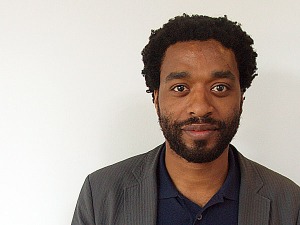 Chiwetel Ejiofor
Chiwetel Ejiofor 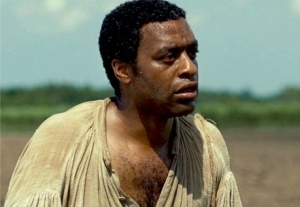 Chiwetel portraying Solomon Northup
Chiwetel portraying Solomon Northup
Mcqueen frames Solomon in a a long shot makes sure that the camera is still, unmoving and captures how although everyone sees Solomon none will dare help and in fact they goo about their day as if he isn’t there. Mcqueen makes sure to capture Solomon’s fellow slaves in the backgorund some even laughing and playing within clear distance of him, the scenes is quite unnerving and unconfortable to watch as it should be, Mcqueen makes you squirm in your seat feeling the urge to look away and for almost a minute you are forced to watch Solomon struggle to stay up on his toes, you see the indifference of the people around him and how common place is kind of inhumanity was.
Patsey’s whipping was one of the hardest if not the hardest scenes to watch in the film, any scene watch someone be tortured to hard to watch but this had an emotional puch that few other have, this is due to Mcqueen use of the long take and minimal movement in his camera.
You watch the unflinching ruthlessness and cruelty of Edwin Epps as he order Solomon to carry out a whipping of almost unspeakable pain to Patsey, Epps unwilling to do it himself at first, she is tied to the tree and stripped to show here bare back and camera stays still to capture every lash, every tear and every cry of mercey that patsey can muster before the pain overwhelms her. Mcqueen makes this long take practically unbearable making sure that the audience obvious cant know what its like they can at least see it in his full display as the horror that it is. The long take makes sure that the concentration isnt broken with cuts that the entire ordeal is shown and that it is understood how barbaric and sadistic it is and how brutal Epps was.
Through these techniques that Mcqueen has used he has really made the most realistic and dramatic portrial of slavery put on screen, the still camera allowing everything to be captured and watched without movement and the long take really keeping the viewer in the moment with the distraction of cuts, his style suited the film quite well.
The Horror in “The Birds”.
The Birds is a 1963 suspense/horror film directed by Alfred Hitchcock, loosely based on the 1952 story “The Birds” by Daphne du Maurier. It tells the story of sudden and unexpected bird attacks that take place in the town of Bodega bay, California.
It stared and ‘introduced’ Tippi Hedren, also starred Rod Taylor, Jessica Tandy, Suzanne Pleshette and a young Veronica Cartwright.
The Birds feels the closest that Hitchcock ever made a monster horror film. He imploys horror film tropes he may have learned from making pycho and apply them here.
The film takes the basic concept of the original story by focusing heavily on the bird attacks and how dangerous and horrifying they are but it changes the setting, main characters and basic narrative. There were elements of The Birds that felt like a horror movie; the small secluded town under attack from a mysterious almost mystical force, the sexually liberated young attractive woman being attacked, and the ominous score building suspense. These are just observations rather than actual points.
The really interesting characters were the townspeople, although they only appear in one scene they all conveyed familiar film tropes or characterizations. There’s the scientist/intellectual skeptic who denounces the possibility of any such event through facts and logic.
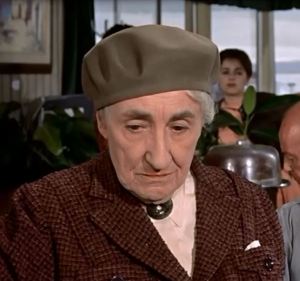 In The Birds it’s the amateur Ornithologist, she says that’s it is impossible and the birds couldn’t possibly be attacking or different species working together.
In The Birds it’s the amateur Ornithologist, she says that’s it is impossible and the birds couldn’t possibly be attacking or different species working together.
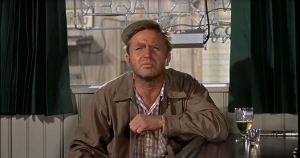 Then there’s the town drunk that proclaims the end of the world. In the film he recites scripture with immense accuracy although being quite inebriated and insists that it’s the apocalypse.
Then there’s the town drunk that proclaims the end of the world. In the film he recites scripture with immense accuracy although being quite inebriated and insists that it’s the apocalypse.
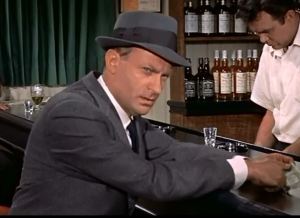 Although not really part of the town there’s the loud overly opinionated outsider that irritates the locals and the viewer whose only purpose is to be killed and prove to the people that it’s all true.
Although not really part of the town there’s the loud overly opinionated outsider that irritates the locals and the viewer whose only purpose is to be killed and prove to the people that it’s all true. 
It’s not unusual to see tropes in a film and some of these aren’t the most conventional horror movie tropes but seeing as Hitchcock made The Birds right after psycho it isn’t as surprising. These characters presented in the local town diner where they all seem to eat, gives a fair idea of a town where people from all walks reside and where ideas are expressed freely and the people seem to all know each other or are at least know their names.
Who are the real ‘Freaks’?
The film Freaks (1932) was directed by Todd Brownings and is based on the short story Spurs by Tod Robbins.
The film unlike the short story humanizes the “freaks”, focusing on their human issues instead of their physical atributes, this gives the message that a ‘freak’ isn’t someone with a physical deformities but someone that treats their fellow human with malice and distain.
The Freaks as they are known are portrayed similarly, but with slight differences in the film. The main characters in the film embody many of the features of their counterparts in the story.
 Jacque and Hans both fall in love with an Amazonian blonde woman; they are both romantics and are deeply angered when mocked. Jeanne and Cleopatra are both selfish, resentful of the dwarf and want to use him for his wealth. The strong man was more charming in the story he seemed more of a big dimwit in the film. Hans seems less spiteful and vengeful in the film, although he ultimately gets some revenge; he isn’t shown as cruel, but more like a fool that didn’t see what was under his nose.
Jacque and Hans both fall in love with an Amazonian blonde woman; they are both romantics and are deeply angered when mocked. Jeanne and Cleopatra are both selfish, resentful of the dwarf and want to use him for his wealth. The strong man was more charming in the story he seemed more of a big dimwit in the film. Hans seems less spiteful and vengeful in the film, although he ultimately gets some revenge; he isn’t shown as cruel, but more like a fool that didn’t see what was under his nose.
 The introduction of a second love interest with Frieda, knowing that she actually loved Hans and cared for him added more sympathy to the situation.
The introduction of a second love interest with Frieda, knowing that she actually loved Hans and cared for him added more sympathy to the situation.
Unlike the short story the movie Freaks spends more time with the rest of circus performers; we see them eating, laughing together, and they even have romantic relationships with ‘normal’ people as in the case of the siamese twins. In the short story the rest of the freaks are not really explored, they have moments of what appears as almost comic relief and aren’t described further beyond what physical deformity earned them a specific nickname.
 It’s good to see the film expand on that and show that the circus environment is close, they look out for one another and seek retribution if one of them is wronged. They even have a chant they use as form of acceptance, “One of us! One of us! Gooble-gobble, gooble-gobble!”, they have formed a family like struture with one another bron from being outcasts. The freaks could have simply been a background gimmick, but they served a memorable part in the narrative.
It’s good to see the film expand on that and show that the circus environment is close, they look out for one another and seek retribution if one of them is wronged. They even have a chant they use as form of acceptance, “One of us! One of us! Gooble-gobble, gooble-gobble!”, they have formed a family like struture with one another bron from being outcasts. The freaks could have simply been a background gimmick, but they served a memorable part in the narrative.
The way the character fit in the story they seemed to be from a fairy tale or a fable of some sort, they served specific functions and were rarely out of their personas. The film makes the point as in the short story to ask who the real ‘Freaks’ are? Is it the sideshow performers who are kind and live their lives the best they can or the so-called ‘normal’ people who are mean spirited and corrupt and, like a fairy tale of fable it ends with morale for us to follow probably that we are all the same, and to mistreat or belittle someone for being different or even freakishly different is inhuman.

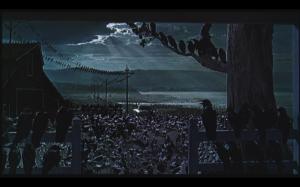
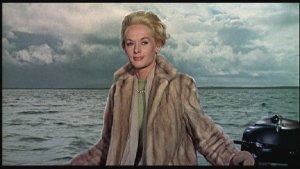
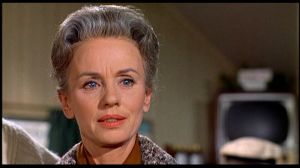

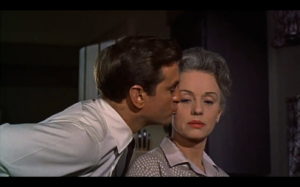

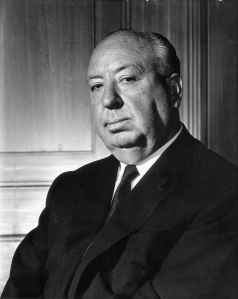
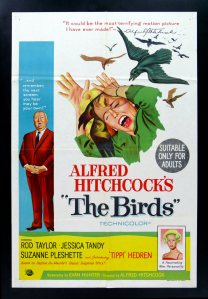
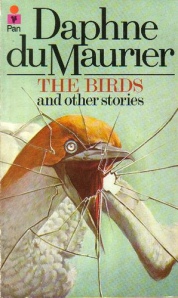

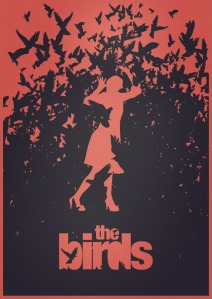
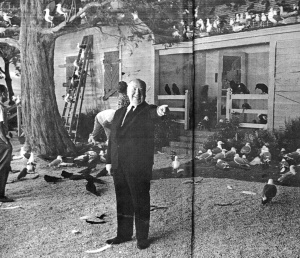
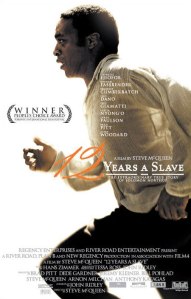


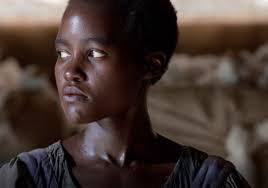
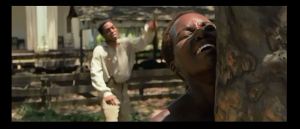
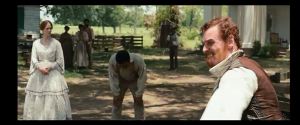
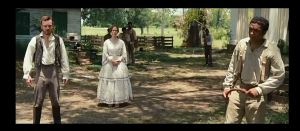
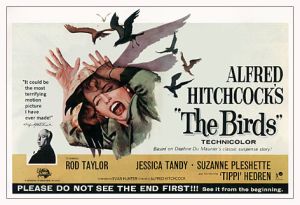
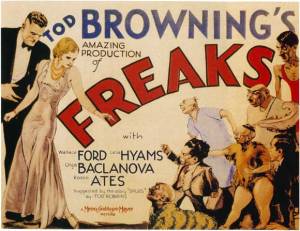
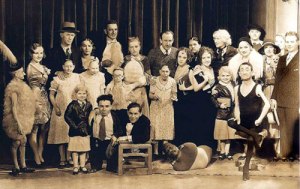
Recent Comments